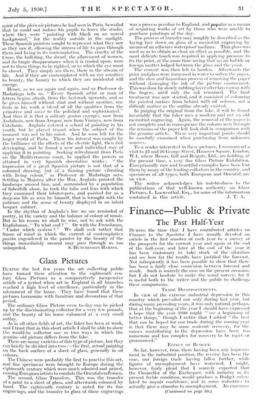Glass Pictures
DURING the last few years the art collecting public have turned their- attention to the eighteenth cen- tury Glass Pictures as a comparatively inexpensive article of a period when art in England in all branches reached a high level of excellence, particularly in the adornment of the home. They have found that these pictures harmonize with furniture and decoration of that period.
The ordinary Glass Picture even to-day can be picked up by the discriminating collector for a very few pounds, and the beauty of his home enhanced at a very small outlay.
As in all other fields of art, the faker has been at work, and I trust that in this short article I shall be able to show the would-be collector one or two ways in which the genuine old picture differs front the fake. There arc many varieties of this type of picture, but they can briefly be divided into two :—the first, actual painting on the back surface of a sheet of glass," generally in oil colours.
The Chinese were probably the first to practise this art, and fine specimens were brought to Europe during the eighteenth century which were much admired and prized, causing European artists to emulate the Oriental craftsmen. The second, Glass Transfers. This was the transfer of a print to a sheet of glass, and afterwards coloured by hand. The eighteenth century is noted for its fine engravings, and the transfer to glass of these engravings was a process peculiar to England, and popular as a means of acquiring works of art by those who were unable to purchase paintings of the day.
The process of transfer may roughly be described as the laying face down on glass of a mezzotint engraving by means of an adhesive waterproof medium. Thin glass was used so as to obtain as clear an effect as possible, and the most delicate touch was required in applying pressure to fix the print, at the same time seeing that nO air bubble or foreign matter lodged between the glass and the print.
The cement was then left to harden. Afterwards the print and glass were immersed in water to soften the paper, and the slow and hazardous process of removing the paper without damaging the-ink of the picture eommenced. This was done by slowly rubbing layer after layer away with the fingers, until only the ink remained. The final treatment was now started, and it consisted of colouring the printed surface from behind with oil colours, not it difficult matter as the outline already existed.
In judging the original from the fitke, it will be found invariably that the faker uses a modern and not an old mezzotint engraving. Again, the removal of the paper is not complete and in consequence the colours seen t hrough the remains of the paper left look dull in comparison with the genuine article. These very important points should be carefully examined when purchasing front unknown
sources. • To a reader interested in these pictures, I recommend a visit to 25 and' 0 George Street, Hanover Square, London, W.1, where Messrs. Gill and Reigate, Ltd., are holding, at the present time, a very fine Glass Picture Exhibition. Exceptionally rare and beautiful examples have been lent them by many of the leading collectors in the country, and specimens of all types, both European and Oriental, arc on view.
The writer acknowledges his indebtedness to the publications of that well-known authority on Glass Pictures, L. Loewenthal, Esq., for some of the information










































 Previous page
Previous page